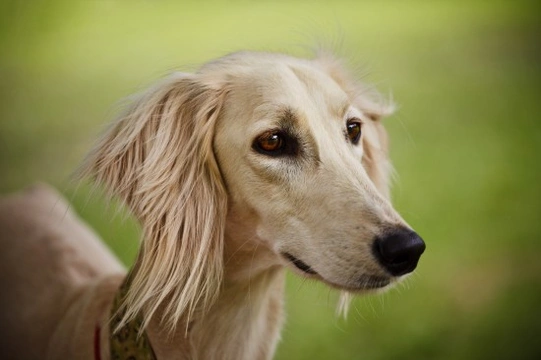
Saluki dog hereditary health and average longevity
The saluki is a breed of sighthound that is also known by various other names, including the Arabian greyhound and the Sloughi. They are one of the oldest known breeds of domestic dogs, and historically travelled with nomadic tribes throughout the Middle East, along the Silk Road. Widely used to hunt for prey animals such as hare and gazelles in their native lands, the saluki can be found in two coat variants, being smooth or feathered. Like most sighthounds, they are gentle, friendly dogs that are kind and affectionate, but can be prone to stubbornness.
The saluki stands up to 28” tall at the withers, and can weigh up to 27kg, with males of the breed being slightly larger than females. They are long legged and deep chested, with a long, curved tail, large, soulful eyes, and drooping ears. The saluki coat can be found in a wide variety of colours, including black and tan, tricolour, white, fawn, and cream.
If you love large sighthounds and are keen to own one, but want something a little less common than the greyhound, the saluki might be the right choice of dog for you. In this article, we will look at the average longevity, hereditary health, and recommended health testing schemes that are in place for the breed. Read on to learn more.
Saluki longevity
The average lifespan of the saluki is 12-14 years, which reflects a reasonably long lifespan and a general propensity to good health. The 12 year range reflects the average figure across the board for all breeds of a similar size and build, and at the top end of the scale towards the 14 year mark, brings the saluki in above the average for equivalent breeds.
Genetic diversity
The coefficient of inbreeding statistic for the saluki breed is 9.7%, which is markedly higher than the 6.25% or lower that is considered to be the desirable norm for all pedigree breeds. This indicates the fact that the saluki breed as a whole is subjected to a reasonable amount of inbreeding in order to keep their breed lines viable, and saluki breeders are advised to reduce the coefficient of inbreeding figure within their own breed lines where possible.
Conformation
The saluki is a tall yet lean dog, and one that is not subjected to a high degree of exaggeration or overtyping, making the shape and build of the saluki robust and fit for life. While the saluki is not one of the breeds most prone to developing bloat or gastric torsion, the deep yet narrow chest of the breed may pose an elevated risk for dogs of the breed, something that all saluki owners should be aware of.
Health testing for the saluki
The saluki tends to be a robust, healthy dog that is not prone to a high degree of hereditary health problems, and this is reflected by the fact that there are not a huge range of pre-breeding testing schemes in place for the breed.
However, the British Veterinary Association and The Kennel Club advise pre-breeding health screening for a propensity to hip dysplasia, with the breed’s mean hip score being 5. Saluki breeders are advised to only breed from parent dogs that attain a hip score below this figure, in order to raise the hip health of the breed as a whole, and reduce the chances of hip dysplasia within their own litters.
Other health issues
The saluki breed as a whole tends to enjoy good health throughout their lives, and they are not widely considered to be problematic in terms of the potential range of health issues that the breed may be prone to. However, like all pedigree dog breeds, the saluki breed has a slight hereditary predisposition to certain health issues that recur across the breed with a higher degree of frequency than they do within most other breeds.
Potential health issues that the saluki owner or potential owner should be aware of include:
- A condition called ceroid lipofuscinosis, a disease of the lysosomal storage system of the body. This is a neurological defect that leads to problems such as a general shakiness or wobbliness, and weakness of the legs.
- Motor neuron abiotrophy, a progressive condition that causes deformities of the front legs of the dog, and generalised body weakness.
- Black hair follicular dysplasia in dogs with black coats, or with black areas of the coat. This condition does not affect hair of colours other than black.
- Leukodystrophy, a condition that leads to a loss of myelin in the in the body’s nervous system, affecting the spinal cord and the brain. This leads to weakness of the limbs and a loss of coordination, but is relatively rare.
- Patent ductus arteriosus of the heart, a condition that leads to heart disease.
- Thrombocytopenia, a condition in which the immune system of the body destroys its own blood platelets, leading to a condition similar to haemophilia.
- Hypothyroidism or an underproduction of the necessary thyroid hormones, which leads to weight gain and lethargy.



